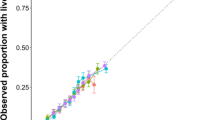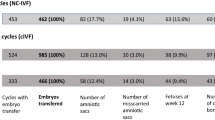Abstract
A comparison of the implantation rates following in vitro fertilization (IVF) and embryo transfer (ET) for four major groups indicates differences in the implantation rates as well as in the incidence of multiple implantation. By assuming that the probability of implantation is the product of two variables, uterine receptivity (U) and embryo viability (E), estimates for U and E are derived for each of the four (VF groups using maximum likelihood methods. The UE model is tested using chi-squared goodness-of-fit methods for predicted implantation rates versus observed. The possibility that differences in U values between groups are due to different ovarian stimulation protocols is discussed, as is the values of the UE model in highlighting differences between IVF groups and its importance in predicting multiple pregnancy rates.
Similar content being viewed by others
References
Trounson A, Wood C: IVF results 1979–1982 at Monash University-Queen Victoria-Epworth Medical Centre. Vitro Fert Embryo Transfer 1984;1:42–47
Jones HW, Acosta AA, Andrews MC, Garcia JE, Jones GS, Mayer J, McDowell JS, Rosenwaks Z, Sandow BA, Veeck LL, Wilkes CA: Three years of in vitro fertilization at Norfolk. Ferti Steril 1984;42:826–834
Lopata A: Concepts in human in vitro fertilization and embryo transfer. Fertil Steril 1983;40:289–301
Edwards RG, Steptoe PC: Current status of in-vitro fertilization and implantation of human embryos. Lancet. 1983;8362:1265–1269
Speirs AL, Lopata A, Gronow MJ, Kellow GN, Johnston WIH: Analysis of the benefits and risks of multiple embryo transfer. Fertil Steril 1983;39:468–471
Jones HW, Acosta AA, Andrews MC, Garcia JE, Jones GS, Mantzavinos T, McDowell J, Sandow BA, Veeck L, Whibley TW, Wilkes CA, Wright GL: What is a pregnancy? A question for programs of in vitro fertilization Fortil Steril 1983;40:728–733
Trounson A, Caro CM, Jessup D: The effect of maternal age of the success rate of in vitro fertilization (IVF). Aust Soc Rep Biol, Proc 16th Annu Conf, 1984, p 55 (abstr)
Kokko E, Janne O, Kauppila A, Vihko R: Cyclic clomiphene citrate treatment lowers cytozol estrogen and progestin receptor concentrations in the endometrium of post menopausal women on estrogen replacement therapy. J Clin Endocrinol Metab 1981;52:345–349
Edwards RG, Fishel SB, Cohen J, Fehilly CB, Purdy JM, Slater JM, Steptoe PC, Webster JM: Factors influencing the success of in vitro fertilization for alleviating human infertility. J Vitro Fert Embryo Transfer 1984;1:3–23
Author information
Authors and Affiliations
Rights and permissions
About this article
Cite this article
Rogers, P.A.W., Milne, B.J. & Trounson, A.O. A model to show human uterine receptivity and embryo viability following ovarian stimulation for in vitro fertilization. J Assist Reprod Genet 3, 93–98 (1986). https://doi.org/10.1007/BF01139353
Received:
Accepted:
Issue Date:
DOI: https://doi.org/10.1007/BF01139353




